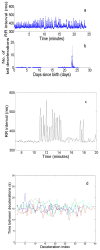Periodic heart rate decelerations in premature infants
- PMID: 20407086
- PMCID: PMC2962445
- DOI: 10.1258/ebm.2010.009336
Periodic heart rate decelerations in premature infants
Abstract
The pacemaking system of the heart is complex; a healthy heart constantly integrates and responds to extracardiac signals, resulting in highly complex heart rate patterns with a great deal of variability. In the laboratory and in some pathological or age-related states, however, dynamics can show reduced complexity that is more readily described and modeled. Reduced heart rate complexity has both clinical and dynamical significance - it may provide warning of impending illness or clues about the dynamics of the heart's pacemaking system. In this paper, we describe simple and interesting heart rate dynamics that we have observed in premature human infants - reversible transitions to large-amplitude periodic oscillations - and we show that the appearance and disappearance of these periodic oscillations can be described by a simple mathematical model, a Hopf bifurcation.
Conflict of interest statement
Figures







References
-
- Buchman TG. Nonlinear dynamics, complex systems, and the pathobiology of critical illness. Curr Opin Crit Care. 2004;10(5):378. - PubMed
-
- Buchman TG, Stein PK, Goldstein B. Heart rate variability in critical illness and critical care. Curr Opin Crit Care. 2002;8(4):311. - PubMed
-
- Glass L, Shrier A, Belair J. Chaotic cardiac rhythms. Chaos. 1986:236–256.
-
- Goldberger AL. Chaos and fractals in human physiology. Sci Am. 1990;262(2):42–49. - PubMed
-
- Goldberger AL, Peng C-K, Lipsitz LA. What is physiologic complexity and how does it change with aging and disease? Neurobiol Aging. 2002;23:23–26. - PubMed
Publication types
MeSH terms
Grants and funding
LinkOut - more resources
Full Text Sources
Medical

